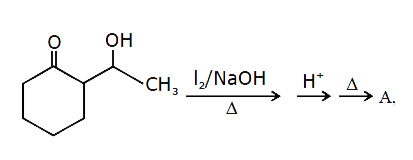LiHΔ−−→× but 2NaHΔ−−→2Na+H2↑⏐⏐ Explain the above observations. Solution in Bengali
The smaller Li+ ion exerts a strong polarising power on highly polarisable H− ion and as a result, the two atoms remain strongly attached by a covalent bond. On the other hand, due to low polarising power of Na+ ion, NaH is essentially ionic & so it dissociates on heating to yield metallic sodium and dihydrogen.
Topper's Solved these Questions
- BOOK - CHHAYA PUBLICATIONCHAPTER - s-BLOCK ELEMENTS EXERCISE - ENTRANCE QUESTION BANK38videos
s-BLOCK ELEMENTS
- BOOK - CHHAYA PUBLICATIONCHAPTER - s-BLOCK ELEMENTS EXERCISE - MCQ HOTSPOT (SINGLE CORRECT TYPE)60videos
s-BLOCK ELEMENTS
- BOOK - CHHAYA PUBLICATIONCHAPTER - s-BLOCK ELEMENTS EXERCISE - SOLVED NCERT EXERCISE56videos
s-BLOCK ELEMENTS
- BOOK - CHHAYA PUBLICATIONCHAPTER - REDOX REACTIONS EXERCISE - PRACTICE SET4videos
REDOX REACTIONS
- BOOK - CHHAYA PUBLICATIONCHAPTER - SOME BASIC CONCEPTS OF CHEMISTRYEXERCISE - PRACTICE SET13videos
SOME BASIC CONCEPTS OF CHEMISTRY
Similar Questions
NO2 is not obtained on heating -
View SolutionWhich of the following compounds transforms baking soda into baking powder-
03:29View SolutionWhat are the common physical and chemical features of alkali metals?
04:55View Solution(a) Find the oxidation numbr of C-1 and C-2 in CH3CH2OH.(b) What is the oxidation number of Mn whenMNO2 is melted with solid KNO3 and NaOH?
03:57View SolutionWhat do you mean by semimolar NaOH solution?
03:03View Solution(a). C−C−O∣∣C−C[O]−−→Δ ltb rgt (b). Me2CH−O∣∣C−Me[O]−−→Δ
(c). Me3C−O∣∣C−Me[O]−−→Δ
(d). .02:36View Solution
.02:36View SolutionEthylcyanide can be converted into ethylamine by (I) overset(Sn // HCl)to (II) overset(H_3O^(+)) to overset(NH_3, Delta)to overset(KOBr, Delta)to
05:19View SolutionThe reaction
2C6H5I+2Naether,Δ−−−−→C6H5−C6H5+2NaI03:44View Solution
I2/NaOH−−−−−→ΔH+−−→Δ−−→A,
A is02:22View SolutionOil +NaOH(aq) overset(Delta)to Glycerol + Soap Above reaction is called :
View SolutionBenzene diazoniumtetrafluoro borate Δ−−→ Product (A) . In the above process product A is
03:53View Solution2LiOHred hot−−−→Li2O+H2O, but 2NaOHred hot−−−→× Explain the above observation.
01:39View SolutionExplain the following observation: 2LiOH overset(Delta)rarr Li_2O + H_2O , 2NaOH overset(Delta)rarr The reaction does not occur
02:01View SolutionExplain the following observation: LiH overset(Delta)rarr The reaction does not occur, 2 NaOH overset(Delta)rarr 2Na + H_2 uarr
02:28View SolutionCH_(3)CH_(3)Brunderset(Delta)overset(aqNaOH)(to)Aunderset(Delta)overset(KMnO_(4)//H^(+))(to)Bunderset(Delta)overset(NH_(3))(to)D.D is ……………………….. .
02:07View Solution

